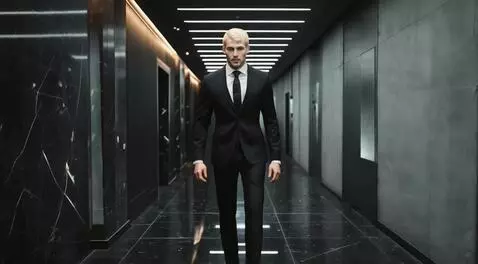
Luma Dream Machine v1.5
# Aspect Ratio: 9:16 # Resolution: 1080p # Format: .mp4 # No text overlays A handheld digital cinema camera with a 35mm lens at f/1.8 follows a man in his 30s with short cropped blonde hair, blue eyes, and a sharp jawline. He wears a fitted black European-cut suit with polished leather shoes. The camera stays approximately two meters behind him at shoulder height, with natural sway and bounce as he walks. Depth of field is shallow, with soft background blur and organic lens behavior throughout the sequence. He moves with silent precision down a dark marble corridor inside a luxury corporate skyscraper. The floor is glossy black stone, the walls are matte gray concrete, and vertical ceiling lights emit a soft white glow, reflected faintly beneath his steps. As he nears a massive vault door—eight feet tall, made of reinforced matte steel with deep cross-ribbing and a glowing perimeter of embedded circuitry—the camera closes in behind him. To the right of the door is a biometric scanner: a recessed rectangular glass panel framed in brushed aluminum, softly pulsing with white concentric rings. He stops. Slowly, he leans toward the scanner. The camera cuts to a **tight close-up of his eye** — sharp blue iris, visible pupil texture, natural skin pores, and faint under-eye shadows. A scanning beam flickers out from the panel, locking onto his iris. The reflection of the beam dances across the surface of his cornea, catching in his eyelashes and subtly lighting the fine lines around his eye. He blinks once. The interface flashes green. The vault lights surge subtly. Everything feels like a lost scene from a high-budget thriller — ultra-cinematic lens behavior, realistic lighting falloff, believable human textures, and no fantasy or sci-fi stylization.
